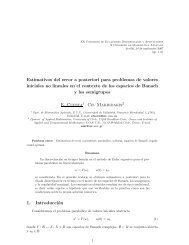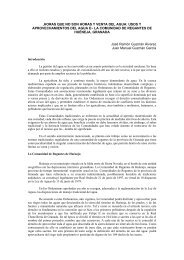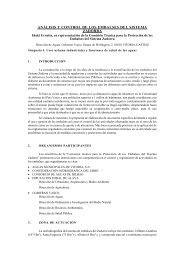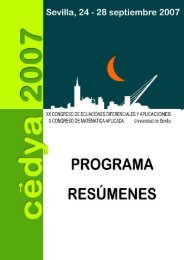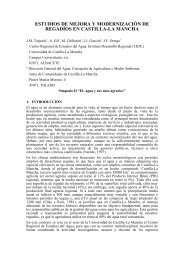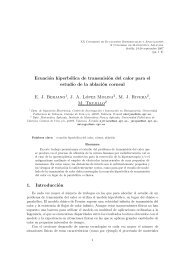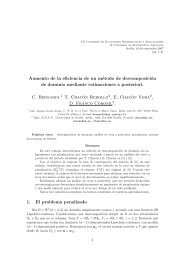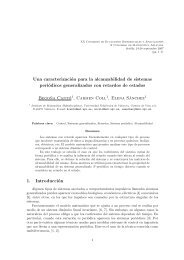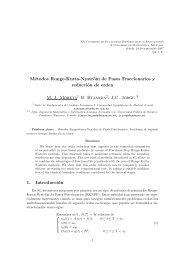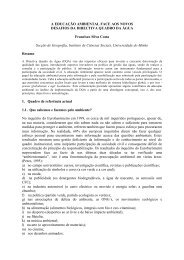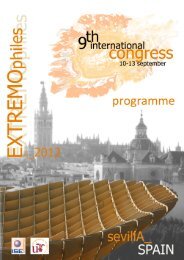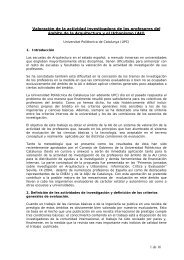LIBRO DE ACTAS (pdf) - Universidad de Sevilla
LIBRO DE ACTAS (pdf) - Universidad de Sevilla
LIBRO DE ACTAS (pdf) - Universidad de Sevilla
You also want an ePaper? Increase the reach of your titles
YUMPU automatically turns print PDFs into web optimized ePapers that Google loves.
Automatic Detection of Melodic Patterns in Flamenco Singing by Analyzing Polyphonic Music Recordings<br />
Salamon and Gómez [SG11, SG12]. Their algorithm is composed of four blocks. First, they<br />
extract spectral peaks from the signal by taking the local maxima of the short-time Fourier<br />
transform. Next, those peaks are used to compute a salience function representing pitch salience<br />
over time. Then, peaks of the salience function are grouped over time to form pitch contours.<br />
Finally, the characteristics of the pitch contours are used to filter out non-melodic contours, and<br />
the melody F0 sequence is selected from the remaining contours by taking the frequency of the<br />
most salient contour in each frame. Further <strong>de</strong>tails can be found in the two aforementioned<br />
references.<br />
4.2 Pattern Recognition Method<br />
The pattern <strong>de</strong>tection method that is used in this paper is an extension of the so-called<br />
“Context-Depen<strong>de</strong>nt Dynamic Time Warping” algorithm (CDDTW), which was originally<br />
proposed by the authors in [PTK03]. Although standard dynamic time warping schemes assume<br />
that each feature in the feature sequence is uncorrelated with its neighboring ones (i.e. its<br />
context), CDDTW permits flexible grouping of neighboring features (i.e. forming feature<br />
segments) in or<strong>de</strong>r to exploit possible un<strong>de</strong>rlying mutual <strong>de</strong>pen<strong>de</strong>nce. This is particularly useful<br />
in the case of noisy pitch sequences, because it permits canceling out several types of pitch<br />
tracking errors, including pitch halving/doubling errors and intervals that are broken to a<br />
sequence of subintervals. Furthermore, in the case of melismatic music, the CDDTW algorithm<br />
is capable of smoothing variations due to the improvisational style of singers or instrument<br />
players. For a more <strong>de</strong>tailed study of the CDDTW, the rea<strong>de</strong>r is referred to [PTK03].<br />
A drawback of CDDTW is that does not take into account the duration of music notes and<br />
focuses exclusively on pitch intervals. Furthermore, CDDTW was originally proposed for<br />
isolated musical patterns (pre-segmented data). The term isolated refers to the fact that the<br />
pattern that is matched against a prototype has been previously extracted from its context by<br />
means of an appropriate segmentation procedure, which can be a limitation in some real-world<br />
scenarios, like the one we are studying in this paper. Therefore, we are here proposing a the<br />
following extension to CDDTW algorithm:<br />
• First, removes the need to segment the data prior to the application of the matching<br />
algorithm. This means that the prototype (in our case the time-pitch representation of a MIDI<br />
pattern) is <strong>de</strong>tected directly on the pitch sequence of the uninterrupted audio stream, i.e. the<br />
pitch sequence that was extracted from the polyphonic fandango.<br />
• Second, takes into account the note durations in the formulation of the local similarity<br />
measure. In addition, the new algorithm permits to search for a pattern iteratively, which<br />
means that multiple instances of the pattern can be <strong>de</strong>tected, one per iteration.<br />
A <strong>de</strong>tailed <strong>de</strong>scription of the extension of the algorithm is beyond the scope of this paper.<br />
Instead we summarize the basic steps:<br />
1.The MIDI pattern to be <strong>de</strong>tected is first converted to a time-pitch representation<br />
where f i is the frequency of the i-th MIDI note, measured in cents (assuming that the<br />
reference frequency is 55 Hz) and t i the respective note duration (in seconds), for a MIDI<br />
pattern of J notes.<br />
2.Similarly, the pitch sequence of the audio recording is converted to the above time-pitch<br />
representation,<br />
where r i is a pitch value (in cents) and tr i is always equal to the short-term step of the feature<br />
extraction stage (10ms in our case), for an audio recording of I notes. In other words, even if<br />
two successive pitch values are equal, they are still treated as two successive short notes,<br />
229



